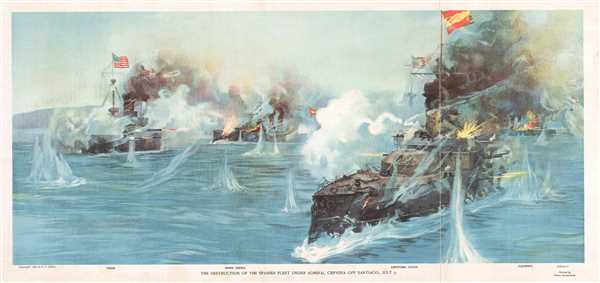1898 Reuterdahl View of the Battle of Santiago de Cuba
BattleSantiago-reuterdahl-1898
Title
1898 (dated) 10.5 x 22 in (26.67 x 55.88 cm)
Description
Before the battle, the Spanish fleet had been blockaded in the harbor for nearly two months. With American and Cuban forces closing in on all sides, the decision was made to run the blockade. On the morning of July 3, a Sunday, the Spanish fleet made their move. Led by Admiral Pascual Cervera in his flagship the Infanta Maria Teresa, the fleet left the shelter of the harbor, and the American fleet immediately opened fire. Of the ships depicted in this view, the Maria Theresa and the Oquendo quickly succumbed to superior firepower. The Cristóbal Colón, the newest ship in the Spanish Caribbean fleet, managed to escape the blockade, but the U.S.S. Oregon immediately gave chase. The Cristobal Colon hugged the Cuban coast, but was not able to get past the Oregon, which was stationed 1.5 miles off the coast. The view depicts the Maria Theresa and the Oquendo in flames and the Cristóbal Colón running at full speed to try to put distance between herself and the Texas and Oregon.
This view was painted by Henry Reuterdahl and published by Peter Fenelon Collier in 1898.
CartographerS
Henry Reuterdahl (1870-1925), a Swedish-American painter, was known for his nautical work and had a strong relationship with the U.S. Navy. He was self-taught, and won a job to be an illustrator-correspondent during the Spanish-American War. He served as a Lieutenant Commander in the U.S. Naval Reserve, and was selected by President Theodore Roosevelt to accompany the Great White Fleet in 1907 to document to voyage. During World War I, he served as head of the poster bureau, and was considered to be America's foremost naval artist. More by this mapmaker...
Peter Fenelon Collier (1849-1909) was an Irish publisher who founded the publishing company P. F. Collier and Son and Collier's Weekly. Collier was born in Ireland and emigrated to the United States at the age of seventeen. Collier's Once a Week was founded in 1888, and by 1892 had a circulation of over 250,000. In 1895, the magazine's name changed to Collier's Weekly: An Illustrated Journal. Learn More...

